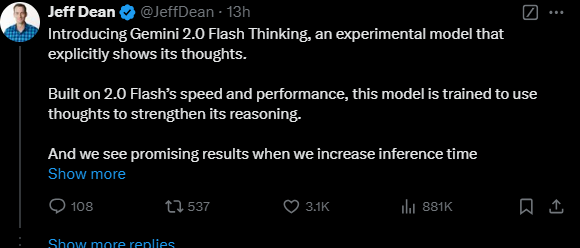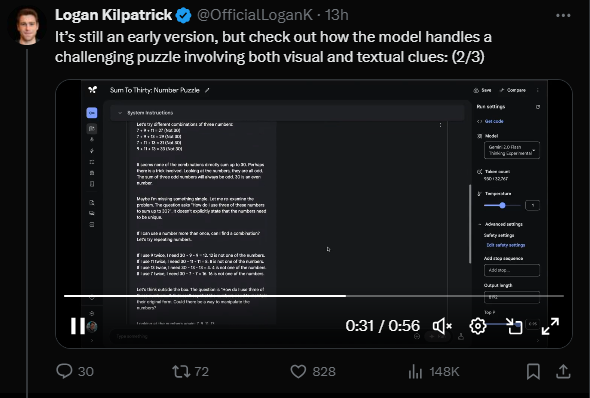On December 19, Google introduced its new AI reasoning model, Gemini 2.0 Flash Thinking, designed to compete with OpenAI’s popular o1 model. Currently in the experimental stage, this model is available for users through Google’s AI studio.
Gemini 2.0 Flash Thinking utilizes advanced reasoning techniques similar to those found in the o1 model. It can pause and consider related prompts before answering, allowing for a deeper analysis of complex problems.
Jeff Dean, a chief scientist at Google DeepMind, highlighted the model’s capabilities in a post on X (formerly Twitter). He explained that this new version builds on the speed and performance of the previous Gemini 2.0 Flash model and is trained to enhance its reasoning by showing its thought process. Dean noted that they see encouraging results when they increase the time spent on calculations.
This new AI model aims to provide users with more accurate and thoughtful responses by considering various angles of a question before delivering an answer. As it is still being tested, feedback from users will likely help improve its functionality in the future.

Google AI Studio product lead Logan Kilpatrick recently shared a demo showcasing Gemini 2.0 Flash Thinking, which he described as the first step in Google’s journey toward improved AI reasoning. This new model is designed to tackle complex puzzles that involve both visual and textual clues.

Earlier this year, OpenAI launched its own AI model called o1. This model uses techniques like reinforcement learning and chain-of-thought reasoning to analyze problems step by step before arriving at a solution. The development of o1 generated a lot of excitement, especially after months of speculation about a secret project known as Project Strawberry.
The release of o1 sparked competition among tech companies, prompting them to develop reasoning models that take extra time to process user prompts before providing answers. For instance, DeepSeek, an AI research company based in China, introduced R1, which reasons through various tasks before concluding. Similarly, Alibaba’s Qwen team launched their reasoning model called QwQ earlier this month.
AI reasoning models are designed to help machines analyze information and make decisions as humans do. They can use different methods, such as deductive reasoning (drawing specific conclusions from general principles), inductive reasoning (making generalizations based on specific observations), and abductive reasoning (forming the best explanation from incomplete data). These models aim to improve how AI systems understand and solve complex problems, making them more effective in various applications.
Despite the excitement around AI reasoning models, there are several concerns about their accuracy and practical use in real-world situations. Some researchers argue that large language models (LLMs) primarily excel at recognizing patterns in data and predicting which words are likely to come next in a sentence, essentially making educated guesses.
Additionally, using AI reasoning models can be expensive due to their high computing requirements. This has led some people to question whether these models will be sustainable and effective in the long term.










